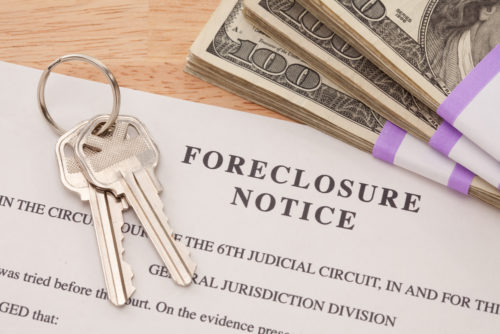Prior to the recession that occurred in 2007-2009, home foreclosures were a relatively rare event. Despite upswings in the housing market that have occurred in the years since then, foreclosures continue to be a huge problem for U.S. residents. According to data collected in 2017 by the Federal Deposit Insurance Corporation (FDIC) 1 in every 200 homes will be foreclosed upon each year.
Worse yet, the FDIC found that 6 in 10 homeowners wish they better understood the details of their mortgage. Additionally, 6 in 10 homeowners who are delinquent in their mortgage payments are unaware of how to prevent default, foreclosure, and the eventual loss of their home if they are unable to make payments.
Below we explore what you need to know about foreclosure, how to prevent it, and how to improve your credit score should your house be foreclosed upon.
Table of Contents
What Does Foreclosure Mean?
If your house goes into foreclosure, that means that you as a borrower have defaulted on your home loan, and the bank or lending agency has chosen to recover the remaining mortgage balance by selling the home. Foreclosure is one in a series of actions taken if the borrower is unable to pay their outstanding debts, or is unable to sell the property through short sale.
When you see a foreclosed home on the market, it simply means that the lending institution is attempting to make up the balance of the loan that remains unpaid by the initial borrower.
There are two types of foreclosure: ones that are voluntary and ones that are forced.
What is a Voluntary Foreclosure?
Voluntary foreclosures occur when the borrower has determined that they will be unable to make future home payments, and they choose to contact the lender in order to initiate the foreclosure process.
Borrowers might make the decision to voluntarily foreclose their home if they know there is no way to make future payments on their mortgage. It can be a smart move for those who know they are living beyond their means, have a sudden job loss, experience the death of the primary breadwinner, or hope to move into a more fiscally stable situation.
Some even choose to default on their home loans strategically knowing that their current home has become more expensive than its actual value.
“Sometimes a property is so far underwater—where you owe more than your home is worth—that it could take years before the home regains all of its value,” writes Amy Lofsgordon, an attorney with expertise in foreclosure, collections, and debt. “If that happens, borrowers sometimes choose to stop making payments, even if they could afford to stay current, simply because the home has become a bad investment. This is known as strategic default, which is sometimes called voluntary foreclosure or ‘walking away.’”
She also notes, however, that there can be severe consequences for doing so, depending on the laws in the states in which you live.
What is an Involuntary Foreclosure?
An involuntary foreclosure, on the other hand, is a foreclosure that is initiated by the lending institution in order to take possession of the home to recover their losses. Typically, in this situation the borrower remains liable for the full amount of the debt owed, meaning that if the house sells for less than the debt owed, the borrower is responsible to make up the balance.
Involuntary foreclosure is typically the last option for borrowers who are unable to make payments on their home loans. There are often a laundry list of alternatives that borrowers can take advantage of before foreclosing on their homes, such as negotiating a reduction in mortgage payments, or refinancing their home loan in an effort to make their payments more manageable.
Foreclosure vs Repossession
Housing repossession and foreclosure are both legal processes that end in a creditor or lending institution taking away your home. While the processes may seem similar, there are a few major differences.
In foreclosure, a home is sold as collateral after the borrower has defaulted on their home loan. In contrast, housing repossession is a more general term for when a mortgage lender takes ownership of a property after bills remain unpaid. Put simply, housing repossession is a consequence of foreclosure.
What Does REO Foreclosure Mean?
When you see a house listed as REO, or Real Estate Owned, it means that a lender — normally a bank, government agency, or government loan insurer — owns the property due to a foreclosure. These are also more colloquially known as “bank owned” properties.
In cases like these, an REO property becomes the responsibility of the bank’s asset manager, who works to try to find a buyer for a home. They work with real estate agents to make this process more seamless. In many cases, these homes are in rough shape, as there is nobody actively taking care of them or maintaining the premises, and they can be listed on the market for years.
Since lending agencies are typically trying to recuperate a lack of payment from the initial borrowers, they’re often willing to sell an REO home for less than market value, which makes them an ideal investment for individuals interested in flipping properties or those looking for fixer-uppers.
In this state of foreclosure, lenders typically sell the house as-is and are unlikely to negotiate the price or chip in for repairs on the home. It also helps if buyers are willing to make an offer that has financing lined up and a significant deposit.
Types of Foreclosure
In the United States, there are two types of foreclosure processes; which process will be used depends on the individual state in which the property lies.
Foreclosure by Judicial Sale
Judicial foreclosure is allowed in each of the fifty states. The process occurs when the lender files a civil lawsuit against the borrower, and the court takes over the rest of the process. Once the lender files a foreclosure lawsuit in court, the borrower then receives a summons and a copy of the foreclosure complaint filed by the lender or institution.
From this point, the borrower can decide whether or not they want to allow the foreclosure to continue, or if they choose, they can contest to the claim in court. After testimonies are heard and evidence is examined, a judge will then decide whether or not to allow the sale to proceed. In the event that the sale is approved, the judge will also set the date for the sale.
Once a date is set, a sheriff, judge, or other officer of the judiciary conducts a live auction. If nobody buys the property, the assets become property of the bank where they are known as an REO property.
Non-Judicial Foreclosure
Some states also offer the option for banks and lenders to sell homes through a non-judicial foreclosure process. In these cases, the deed of trust used to purchase the home authorizes a “trustee” to foreclose on the property, should the borrower default on their home loan. The laws for this vary by state, including how much notice the trustee must give the homeowner before the property can be put on the market.
After the borrower is served with a notice of default, the homeowner may have the opportunity to reinstate by making up for their missing payments and/or working out a payment plan with the lender. If this is not possible, they’ll receive a notice of intent to sell the property on a specific date.
Non-judicial foreclosures do not have to be conducted by a government official. In most cases the lender will appoint a third party sales agent. If the home is not sold, the home becomes property of the bank or lending institution.
When Does a Home Go Into Foreclosure?
Foreclosure is a lengthy process that varies depending on the laws in state that you live in. It can also be stalled or prevented, so the process may not be as linear, or it could have stops and starts throughout the process.
Missed Mortgage Payments
When borrowers take out a home loan, they are subject to the terms and conditions present in their contract. Part of that means making monthly payments back to the lending institution from which they borrowed. Typically, the foreclosure process begins when you miss 120-180 days (4-6 months) of monthly payments.
As noted before, there are steps individuals can take to prevent mortgage payments from going into default and subsequent foreclosure.
If you’re hoping to prevent default, it may be prudent to write a letter of hardship to your lender, detailing your situation and work with them to find a solution you can both agree on. Solutions could include extending the repayment period, suspending payments (with their permission) for a few months, tacking on missed payments to the tail end of the loan, or refinancing.
In some cases it may also be possible for you put your home up for short sale, which has the potential to benefit all parties.
“For the homeowner who must sell for less than what’s owed on their mortgage, it can be a way out without sustaining as much damage to their credit as they would in foreclosure,” NPR’s Yuki Noguchi writes. “For the mortgage lender, it means taking less of a loss than if the property goes into foreclosure. And for the buyer, a short sale represents a good deal on a house.”
While the process can be mutually beneficial, short selling is a difficult process, and ultimately it’s up to your lender to determine whether or not you and your home qualify.
Public Notice: Mortgage Goes Into Default
When you fail to make your home mortgage payments on time and do not take the steps necessary to prevent foreclosure, you will receive a notice of default from your lender. A notice of default is a serious action taken by a lender that notifies the borrower that their delinquent payments have breached the contract outlined in their home loan agreement.
In some cases, lenders will give the borrower a grace period before taking further action, or indicate in some way that the borrowers might have time to negotiate the terms of their contract. In other cases, the notice of default may serve as a final notification that action is being taken.
Pre-Foreclosure Grace Period
After you’re served a public notice of default, the property is placed in a pre-foreclosure stage. In short, the lender has informed the borrower of their defaulted status and now has a certain period of time, variable by state, to pay the amount that is in default. Many states have a grace period that lasts for six months, but in others, that time can be less.
“Texas processes foreclosures fastest, with an average of 90 days,” according to data compiled by NPR. “At the other end is New York, with an average of 1,019 days. Experts say there are pros and cons to getting through them both too fast and too slow. The national average is 348 days to complete a foreclosure.”
This grace period also gives individuals a chance to sell their home if they are unable to make consistent payments. In cases like these, the borrower may be able to get a decent price on their home, while also avoiding the consequences that come with home foreclosure.
Foreclosure Auction or Trustee Sale
If you are unable as a borrower to obtain the money required to pay the defaulted amount by the time your grace period is over, the property is removed from pre-foreclosure. From there, typically homes are put up for auction. The amount of time it takes for the lender to put the home up for auction varies. Some homes are put up for auctions within months of default, while others can take more than a year.
This provides opportunities for home buyers to take advantage of properties that are typically priced under market value. In order to find these auctions, look no further than your local newspaper, as all foreclosures are required by law to be listed in newspapers of general circulation.
In those advertisements, you’ll find a legal description of the property, the terms and conditions of the sale, and the date, time, and place of the auction. In addition, they typically also indicate that in order to bid at the auction you will have to bring certified funds in a certain dollar amount equal to 10 percent of the outstanding balance owed to the lender. What you won’t find is information about property features, such as square footage of the lot, the number of bedrooms and baths, or the condition of the property.
This is part of what makes bidding on foreclosed homes so risky, and buyers ought practice caution.
“All foreclosures are sold in ‘as-is’ condition,” writes Washington Post contributor and real estate lawyer Harvey S. Jacobs. “Because lenders legally do not have the right of possession of the home until the auction is completed, there is typically no opportunity to conduct a pre-bid interior inspection, unless the current owner is willing to allow you to enter his home to conduct an inspection.”
At most, you’ll be able to find out information about the home through public records, which allows you to discover who owned the home, when they bought it, and in some cases how much they originally borrowed.
From there, you will either need to have cash on hand, or go to a reputable lender and pre-qualify for the amount of the home you intend to finance.
What Happens After a Foreclosure?
After a foreclosure sale is completed, and a new homeowner signs a deed with the lending institution, you officially transition from homeowner to tenant. After this is completed, it’s imperative that you find a new place to live, and start preparing for your financial future. In order to do this, there are several possible options moving forward.
Voluntary Vacancy
After your house has been foreclosed upon, you may choose to voluntarily vacate the property after the foreclosure auction. Doing so helps eliminate the need for the new property owner (whether it’s the bank or a new homeowner) to file an eviction lawsuit to remove you. Since there can be consequences for having a foreclosure on a record, having an additional eviction notice on your record can cause potential hardships in finding a place to live.
Eviction
In failing to voluntarily vacate the premises, you are opening yourself up for an eviction lawsuit with the new owner of the home. During an eviction lawsuit, you will be served a three-day notice to vacate the property. After that notice, the new owners can file an unlawful detainer lawsuit with the court in the county you reside in, giving you five days to respond to the lawsuit. From there the case goes to trial, and a date is typically scheduled within 20 days. If the judge finds in the new tenant’s favor, you will have an additional five days to leave the property before locks are changed on the home.
Right of Redemption
In some cases, you may qualify for the “right of redemption”, meaning that you have the right to reclaim your foreclosed property up to the moment of foreclosure auction (or after, in certain states) by paying the lender back what is owed to them. The right of redemption is not universally available in every state, so you’ll need to check individual state laws.
How Foreclosures Affect Your Credit Score
Foreclosures on your credit report are typically frowned upon from a lender’s perspective. According to the credit reporting agency Experian, “It may not be as bad as bankruptcy, but not paying your mortgage and losing your house is very close. The presence of a foreclosure on your credit report probably will make it difficult to obtain new credit at the best rates, especially if you also have problems with other credit accounts.”
Foreclosures typically remain on your credit report for seven years, meaning that your creditworthiness is affected for a fairly long period of time. But by taking control of your debts and building a history of positive payments, you’ll be able to slowly build your credit back up to a satisfactory level.
In order to maximize your debt recovery efforts, be sure to pay credit accounts that are regularly reported to credit bureaus. Doing so will not only help to pad your credit score in the years following your foreclosure, but a creditor or lender who manually reviews your credit report will be able to see that the mortgage was the only thing hurting your credit score, which could result in an application for future credit going in your favor. In addition, it’s best to keep credit card balances at the recommended 30 percent of your credit limit.





